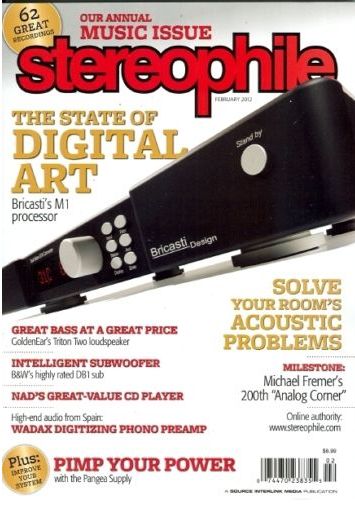OUR EDITORS PICK THE MOST MEMORABLE RECORDINGS OF ALL TIME
AT A TIME IN HISTORY when the music business seems less interested in making anything of lasting value than in churning out disposable music—hits intended to be consumed for a few days via iPod, then left behind—the notion of cherishing the masterpieces, the records to die for, seems a lost art. Yet it's exactly that state of being—as when Lady Gaga's latest outfit commands a bigger spotlight than the recent Pink Floyd reissues—that makes our annual "Records To Die For" feature that much more essential.
Most audiophiles first amass a pile of music, then go out and get them some high-end gear. They may love their brushed knobs and pretty lights, but ultimately it's about consuming the music—letting that timeless, resonant stuff fill your head and your heart with an endless supply of endlessly varied thoughts and feelings. Somehow,
real music—the melodies you'd die for—doesn't get old or lose its power. A new era gives it new meanings, and amplifies those you'd discovered in the past. It's art you can count on—tunes that stand the test of time.
Every year, we ask our contributing editors, both hardware and music, to choose two collections of music they cherish, and to (briefly) tell us why. What follows are their impressions for 2012. Being truthful and unswayed by fashion are hallmarks of this magazine, and things are no different here in "R2D4." So please enjoy these self-evident musical truths. Hopefully, they'll remind you of some of your own. Keep listening!
-Robert Baird
Note: If a recording listed here has previously been reviewed in Stereophile,
whether in "Record Reviews" or in past editions of "Records To Die For," the volume and number of the pertinent issue appear in parentheses at the end of the review. For example, a listing of "(XXXIV-11)" means that a review of the recording appeared in Vol.34 No.11 (November 2011).
JOHN ATKINSON
PETER GABRIEL
New Blood (Special Edition)
with Ane Brun, Melanie Gabriel, Thomas Cawley,
vocals; New Blood Orechestra, Louisa Fuller
(leader), Ben Foster (conductor)
Real World 00038 (2 CDs). 2011. Peter Gabriel, prod.,
arr.; John Metcalfe, prod., arr., orchestrations, mix;
Dickie Chappell, mix, eng.; Scott Barnett,
Tobias Froberg, engs. DDD. TT:2:32:06
I finished reading Walter Isaacason's biography of Steve Jobs as I prepared to write these brief reviews, and was struck by how adeptly jobs re-created himself. He was not an artist as such, but Jobs's life illustrates how the artist who doesn't keep evolving ultimately fails. By that measure, Peter Gabriel's career is a continuing success, even if this 2011 album comprises second examinations of his earlier songs. Gabriel's
Scratch My Back, which featured empathetic arrangements by John Metcalfe of other people's songs, was one of my 2011 "R2D4" picks; in
NEW BLOOD, Metcalfe applies his orchestral imagination to a selection of Gabriel's own material. And again, there is no drum kit, no rhythm section. The sound of the orchestra, recorded at Air Lyndhurst in London, is rich and large, reminiscent of that on Joni Mitchell's
BOTH SIDES NOW, from 2000, which was also recorded there. Occasionally the space on the accompaniment stands too much in contrast to the closeness of Gabriel's voice, particularly in the final track,
Solsbury Hill, which, for reasons explained in the booklet, is separated from the rest of the album by almost five minutes of ambient sound. Two favorites of mine from
SECURITY, Wallflower and
San Jacinto, are here, along with two favorites from
SO, In Your Eyes and
Don't Give Up, though Norwegian singer Ane Brun's excessive vibrato in the latter takes some getting used to after the glory of Kate Bush in the original, and the purity of Paula Cole in 1994's
SECRET WORLD LIVE version. The second CD mainly comprises the orchestral backing tracks, which, if musically incomplete, bear witness both to the inventiveness of Metcalfe's arrangements and the completeness of Gabriel's musical imagination.
MICHAEL FREMER
TOM RUSH
The Circle Game
Elektra EKS-74018 (LP). 1968. Arthur Gorson, prod.;
Bruce Botnick, Brooks Arthur, engs. AAA. TT: 38:16
This quintessentially moody New England winter's evening album is where many listeners first heard the songs of Joni Mitchell, James Taylor, and Jackson Browne. Rush covers
Tin Angel, Something In The Way She Moves, Urge For Going and
Sunshine, Sunshine among others, and sequences them to chronicle the arc of a relationship. Crack studio cats Bernard Purdie, Eric Gale, Buddy Lucas, and Herbie Lovelle provide backup, along with the occasional string section. Preppy and tasteful (perhaps a bit too), with cover photography by Linda Eastman—and, of course, given the engineering pedigree, the sound is superb on the tan Elektra label.
PAUL MESSENGER
JONI MITCHELL
Mingus
Asylum AS 53 091 (LP), Warner Bros. 7559605572
(CD). 1979/1986. Joni Mitchell, Steve Katz, mix;
Henry Lewy, Jerry Solomon, eng., mix; Bernie
Grundman, mastering. AAA/AAD. TT:37:20
One of the least well known of Joni Mitchell's albums,
MINGUS is frequently and unjustly overlooked. Yet it's the default Mitchell that finds its way onto my turntable, thanks to a combination of fine musicianship from the Weather Report crew (Wayne Shorter, and Jaco Pastorius at his very best) and excellent sound (on my LP). Although the rap interludes between tracks can become tedious with repeated playing, it has arguably the finest version of
The Dry Cleaner From Des Moines I've ever heard, with Mitchell's impeccable timing matching the band's.
In the interest of this website, only Joni Mitchell related and/or mentioned reviews have been included here from the original 13 page article.

Comments:
Log in to make a comment